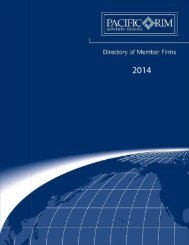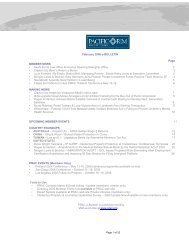A Guide to the Law of Securitisation in Australia - Clayton Utz
A Guide to the Law of Securitisation in Australia - Clayton Utz
A Guide to the Law of Securitisation in Australia - Clayton Utz
- No tags were found...
You also want an ePaper? Increase the reach of your titles
YUMPU automatically turns print PDFs into web optimized ePapers that Google loves.
7 The regulation <strong>of</strong> <strong>the</strong> participation by authoriseddeposit-tak<strong>in</strong>g <strong>in</strong>stitutions <strong>in</strong> securitisations7.1 <strong>Australia</strong>n Prudential Regulation Authority guidel<strong>in</strong>es7.1.1 IntroductionThe <strong>Australia</strong>n Prudential Regulation Authority (APRA) isresponsible for regulat<strong>in</strong>g, amongst o<strong>the</strong>rs, authorised deposittak<strong>in</strong>g<strong>in</strong>stitutions (ADIs). The regulation <strong>of</strong> ADIs has <strong>the</strong> effec<strong>to</strong>f br<strong>in</strong>g<strong>in</strong>g under APRA’s authority <strong>Australia</strong>n build<strong>in</strong>g societiesand credit unions <strong>in</strong> addition <strong>to</strong> <strong>the</strong> Reserve Bank <strong>of</strong> <strong>Australia</strong>’s(RBA) previous mandate <strong>to</strong> regulate <strong>Australia</strong>n-owned banks,foreign subsidiary banks and branches <strong>of</strong> foreign banks.APRA has powers under section 11AF <strong>of</strong> <strong>the</strong> Bank<strong>in</strong>g Act 1959<strong>to</strong> make prudential standards for ADIs and <strong>the</strong>ir hold<strong>in</strong>gcompanies.APRA’s Prudential Standard APS 120 – Funds Management &<strong>Securitisation</strong> (APS 120) became effective on 1 Oc<strong>to</strong>ber 2000.APS 120 applies <strong>to</strong> <strong>the</strong> participation by ADIs <strong>in</strong> all capacities,both with<strong>in</strong> <strong>Australia</strong> and overseas, <strong>in</strong> <strong>the</strong> securitisation <strong>of</strong> assets(whe<strong>the</strong>r or not <strong>the</strong> ADI is <strong>the</strong> sponsor).Some <strong>of</strong> <strong>the</strong> pr<strong>in</strong>ciples <strong>in</strong> APS 120 are also <strong>in</strong>tended <strong>to</strong> apply <strong>to</strong>foreign banks operat<strong>in</strong>g <strong>in</strong> <strong>Australia</strong> through branches. Whilst<strong>the</strong> capital adequacy treatment <strong>of</strong> <strong>the</strong>ir <strong>in</strong>volvement is notregulated by APS 120, foreign banks are required <strong>to</strong> comply withits disclosure and separation provisions (which are dealt withbelow).In APS 120, APRA warns that securitisation exposes an ADI <strong>to</strong>moral or commercial pressure <strong>to</strong> support a securitisation vehiclebeyond its legal obligations. A fundamental pr<strong>in</strong>ciple underly<strong>in</strong>gAPS 120 is that ADIs must resist <strong>the</strong>se pressures and onlyprovide support <strong>to</strong> a securitisation vehicle strictly <strong>in</strong> accordancewith <strong>the</strong>ir formal legal obligations.Where <strong>the</strong> <strong>to</strong>tality <strong>of</strong> an ADI’s <strong>in</strong>volvement <strong>in</strong> funds managementand securitisation suggests that <strong>the</strong> overall level and/orconcentration <strong>of</strong> risks has become excessive relative <strong>to</strong> itscapital, APRA may require that ADI <strong>to</strong> ma<strong>in</strong>ta<strong>in</strong> a buffer above<strong>the</strong> m<strong>in</strong>imum capital ratio.The approach <strong>of</strong> APS 120 is <strong>to</strong> concentrate on three aspects. Thefirst is <strong>to</strong> attempt <strong>to</strong> m<strong>in</strong>imise <strong>the</strong> moral or commercial pressureson an ADI by ensur<strong>in</strong>g that <strong>the</strong>re is sufficient separation between<strong>the</strong> ADI and a securitisation vehicle and for <strong>the</strong>re <strong>to</strong> be adequatedisclosure <strong>to</strong> <strong>in</strong>ves<strong>to</strong>rs <strong>of</strong> an ADI’s limited role.The second is <strong>to</strong> outl<strong>in</strong>e <strong>the</strong> requirements that need <strong>to</strong> besatisfied if an ADI provides facilities <strong>to</strong> a securitisation vehicleand <strong>to</strong> specify <strong>the</strong> capital that needs <strong>to</strong> be held aga<strong>in</strong>st <strong>the</strong>se.The third is <strong>to</strong> set out <strong>the</strong> requirements that must be satisfied <strong>in</strong>order for an ADI <strong>to</strong> be relieved <strong>of</strong> <strong>the</strong> need <strong>to</strong> hold capital aga<strong>in</strong>stassets transferred by it <strong>to</strong> a securitisation vehicle.7.1.2 Separation and disclosureAPS 120 requires that an ADI must ensure that a securitisationvehicle should stand “clearly separate” from any ADI <strong>in</strong>volved <strong>in</strong><strong>the</strong> scheme. To achieve this, <strong>the</strong> vehicle should not <strong>in</strong>clude <strong>the</strong>words “bank, build<strong>in</strong>g society, credit union, authorised deposittak<strong>in</strong>g <strong>in</strong>stitution or ADI” <strong>in</strong> its name. An ADI cannot have anyownership or beneficial <strong>in</strong>terest <strong>in</strong> <strong>the</strong> vehicle, or control it foraccount<strong>in</strong>g purposes, and <strong>the</strong> ADI must limit <strong>the</strong> number <strong>of</strong> itsdirec<strong>to</strong>rs on <strong>the</strong> board <strong>of</strong> <strong>the</strong> vehicle. In addition, <strong>the</strong> ADI shouldnot itself act as manager or trustee <strong>of</strong> <strong>the</strong> vehicle (but can do thisthrough a subsidiary which is not itself an ADI).APS 120 also requires that any market<strong>in</strong>g materials (eg. an<strong>in</strong>formation memorandum) should not give <strong>the</strong> impression <strong>to</strong><strong>in</strong>ves<strong>to</strong>rs that <strong>the</strong> vehicle is backed by <strong>the</strong> ADI beyond any legalobligations <strong>to</strong> which it has formally committed itself. Inparticular, <strong>in</strong>ves<strong>to</strong>rs should be unambiguously <strong>in</strong>formed <strong>in</strong> writ<strong>in</strong>gthat <strong>the</strong> securities do not represent deposits or o<strong>the</strong>r liabilities <strong>of</strong><strong>the</strong> ADI, that <strong>the</strong> securities are subject <strong>to</strong> <strong>in</strong>vestment risk andthat <strong>the</strong> ADI does not stand beh<strong>in</strong>d <strong>the</strong> capital value and/orperformance <strong>of</strong> <strong>the</strong> securities issued by <strong>the</strong> vehicle. An<strong>in</strong>formation memorandum must display this prom<strong>in</strong>ently(generally as a stand-alone item on <strong>the</strong> <strong>in</strong>side front cover) and<strong>in</strong>ves<strong>to</strong>rs must sign an acknowledgement <strong>to</strong> this effect (except <strong>in</strong>some circumstances where <strong>the</strong> securities are electronicallytraded and it is impractical <strong>to</strong> obta<strong>in</strong> such an acknowledgement).Where an ADI fails <strong>to</strong> comply with <strong>the</strong> forego<strong>in</strong>g, it must holdcapital aga<strong>in</strong>st <strong>the</strong> full value <strong>of</strong> <strong>the</strong> relevant securities. Inaddition, APRA warns that where <strong>in</strong>ves<strong>to</strong>rs are given <strong>the</strong>impression that <strong>the</strong> securities are backed by <strong>the</strong> ADI, it may beprecluded entirely from engag<strong>in</strong>g <strong>in</strong> securitisation activities.One <strong>of</strong> <strong>the</strong> requirements for “separation” <strong>of</strong> securitisationentities under APS 120 is that <strong>the</strong> ADI should not “control” <strong>the</strong>entity such that it would need <strong>to</strong> be consolidated with <strong>the</strong> ADIfor <strong>Australia</strong>n account<strong>in</strong>g standards. This has caused muchcontroversy <strong>in</strong> recent years as <strong>Australia</strong>n accountants hadhis<strong>to</strong>rically taken a less demand<strong>in</strong>g view <strong>of</strong> <strong>the</strong> relevantaccount<strong>in</strong>g standards than <strong>the</strong>ir European counterparts (although<strong>the</strong> word<strong>in</strong>g <strong>of</strong> <strong>the</strong> standards <strong>in</strong> <strong>Australia</strong> and Europe was almostidentical). The account<strong>in</strong>g firms had periodically tried <strong>to</strong> br<strong>in</strong>g<strong>the</strong> <strong>Australia</strong>n <strong>in</strong>terpretation <strong>in</strong><strong>to</strong> l<strong>in</strong>e with that <strong>in</strong> Europe – only<strong>to</strong> back down each time <strong>in</strong> <strong>the</strong> face protest from <strong>the</strong>ir clients.44






